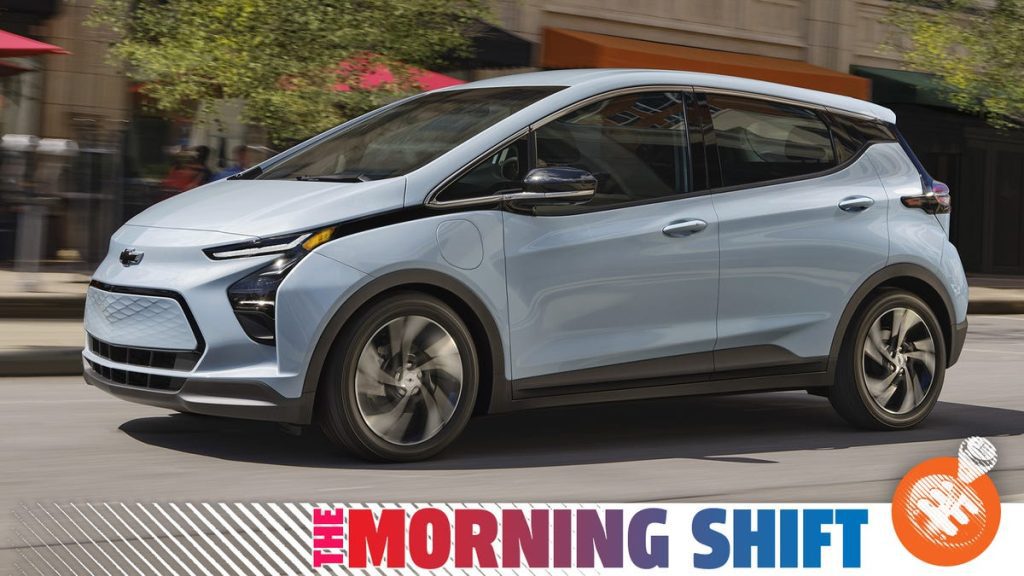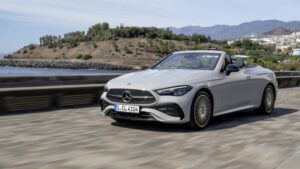The Cheaper-Than-Ever Chevrolet Bolt Is Not Long for This World

Image: General Motors
The Chevrolet Bolt’s days are numbered, Renault lost a third of its sales when it axed its business in Russia, and Honda is still waffling on its Formula 1 future. All that and more in today’s Morning Shift for Tuesday, July 12, 2022.
1st Gear: It Was Always Going to End This Way
The writing has been on the wall for the Bolt and Bolt EUV for some time now. With General Motors moving to its Ultium platform for all of its battery-electric vehicles going forward, the Bolt would carry out the rest of its days on antiquated technology. Plus, sales have always sort of underwhelmed — Americans haven’t demonstrated much interest for compact, archetypal EVs — and then there was that whole thermal runaway recall debacle, for which GM was able to shift much of the blame onto LG for.
Nevertheless, it all spells an end in sight for GM’s first volume EV, something teased by the company’s vice president of marketing to the Detroit Free Press this morning:
“Will Bolt be in our portfolio ‘x’ numbers of years from now? No, it won’t,” Steve Majoros, Chevy’s vice president of marketing, told the Free Press on Monday. “It’s a great product right now. It will be with us for some time. But as we scale and ramp volume here, portfolios change.”
Majoros would not confirm timing for when the Bolt EVs will exit the lineup, but he said, “It’s going to be with us for the foreseeable future and as we ramp portfolio, then we’ll see about the long game for that, so … more to come.”
G/O Media may get a commission
Save 49% on prime day only
NOCO Boost Plus GB40 Portable Jump Starter
Start Dead Batteries
Safe and easy to use car battery jump starter pack without the worry of incorrect connections or sparks. Safely connect to any 12-volt automotive car battery with our mistake-proof design featuring spark-proof technology and reverse polarity protection.
Of course, the vehicles on the horizon due to replace it will be nothing like either Bolt: electric versions of the Equinox, Blazer, Silverado and, of course, the Hummer. That last one weighs about the same as two and a half Bolt EUVs, for the record. The surprisingly roomy, practical, affordable EV doesn’t seem to be a proposition GM wants to bother with anymore.
Until that day comes, however, the Bolt is going to get cheaper. GM is cutting the price of both body styles by $6K, making it the cheapest new EV in America in terms of MSRP. However, GM triggered its phaseout of federal EV tax incentives in 2019, and the company kind of had to do this to stay competitive in the entry-level EV segment. For the record, Nissan is right at the cusp of triggering its phaseout, so even though the Leaf starts at about $2K more than the Bolt, a base model can still be had for less with the maximum $7,500 federal credit.
2nd Gear: Renault Is Not Weathering the Russia Exit Well
Russian buyers were good to Renault. We know this because sales plummeted by 30 percent in the first half of this year, during which the French automaker left the region and sold its majority stake in AvtoVAZ to the state for a ruble. The slump isn’t all down to exiting Russia of course — the supply chain shortage played its role, too.
As part of the selloff deal, Renault could buy its shares back in six years; execs probably can’t wait for that day. From the Wall Street Journal:
Sales at Renault SA fell sharply after the French auto maker withdrew from Russia, its second-largest market, in response to the country’s invasion of Ukraine and the wave of sanctions that followed.
The car maker, which is considering a wide-ranging restructuring, saw its global sales fall by almost 30% over the first six months of the year to just over one million vehicles. Excluding Russia, Renault’s sales volume dropped 12%, due in part to disruptions caused by the shortage of semiconductors.
The large fall in first half sales volume was expected by the market, with Renault shares falling 1.2% in morning trading in Paris.
The auto maker in May announced a deal to cede its 68% stake in Russia’s biggest car company, which produces the Lada brand, to a state-backed entity for one ruble and a six-year option to buy back its shares.
As it stands, France and Italy represent the brand’s top markets at the moment, and it’s eyeing a potentially massive restructuring to get through everything it’s faced in 2022.
3rd Gear: Hyundai Will Build EVs at Home
Hyundai hasn’t opened a new plant in its domestic market in 26 years, but that will reportedly change soon. The manufacturer’s union says construction of a new dedicated EV facility in South Korea is due to begin by 2025.
This news comes after the threat of a strike from its factory workers in the country, and also a recent commitment to new facilities in Georgia. Those two may be related! From Reuters:
In May, Hyundai Motor Group, which houses Hyundai Motor and Kia Corp, said it would invest 63 trillion won ($48.1 billion) in South Korea through to 2025.
Hyundai Motor’s unionised workers in South Korea voted this month for a possible strike for the first time in four years over demands for higher wages. They were also angry at management prioritising investment outside the country.
Hyundai Motor, South Korea’s largest automaker, last opened an automobile factory in South Korea in 1996.
But it said in May it would invest $5.5 billion to build full EV and battery manufacturing facilities in Georgia.
The EV facility in Georgia is scheduled to break ground in early 2023 and begin commercial production in the first half of 2025, according to Hyundai Motor.
Hyundai itself hasn’t officially confirmed the plans for its home market yet, but you’d think it’d want to, to perhaps make its employees in South Korea feel a little less ignored.
4th Gear: Continental, Too
When I think of Continental, I think of tires. I actually just bought some ExtremeContacts for my car and they’ve been lovely. Apparently, Continental does more than rubber, and will be building a new plant in Mexico devoted to hoses and wiring to increase its footprint on this side of the Atlantic. From Automotive News:
Greman [sic] auto supplier Continental will invest $40 million to build a hydraulic hose plant in the central Mexican state of San Luis Potosi, the company said in a statement.
The plant, which is set to open in 2024 and hire around 150 people, will also produce braided and spiral wire components and help supply chain efficiency, Continental said.
“Our goal is to be able to grow in North America,” said Andreas Gerstenberger, head of Continental’s Industrial Fluid Solutions global business unit in the statement.
Continental already operates 21 plants across a dozen Mexican states that make various parts including tires, brakes and computer systems, with 20,000 employees.
I guess this sort of expansion might necessitate a name change to Intercontinental, right? Damn, that tomato got really close to my head you guys.
5th Gear: The Honda F1 Saga Will Never End
I will never cease to be amused by Honda’s shock announcement that it was leaving Formula 1, only for Red Bull to buy up its powertrain division and related IP the very same year the team won it all. Honda’s made its decision, however, and can’t just flip on that. Or can it? It’s honestly getting difficult to follow at this point, but supposedly the Japanese automaker could be lured back by the 2026 engine regulations, the same one that have attracted Porsche and Audi to the sport. From Motorsport.com:
Honda’s 2021 title success, and F1’s major push for a carbon neutral future ahead of its switch to new rules and sustainable fuels from 2026, has prompted speculation that the Japanese manufacturer could be poised for a return.
Such talk was fuelled by a visit last weekend to the Austrian Grand Prix by senior Honda staff, including Honda’s CEO Toshihiro Mibe, its chairman Seiji Kuraishi, plus HRC president Koji Watanabe and its director Yasuaki Asaki.
And while the company insists that there has been no formal change of heart about an F1 programme, it has admitted to following closely how the 2026 engine rules are progressing.
Speaking at the Red Bull Ring, Watanabe said: “Formula 1 is the top motorsports category, so we are always watching what is happening in the F1 world.
“Of course, we just finished and concluded our activities, so nothing [has been] discussed within the Honda company about 2026 season. So, no plan.
“[But] it is not a closed door. My understanding is that F1 is discussing to decide the regulations for 2026, and definitely the direction is carbon neutrality. That is the same direction as us.
“So we don’t have to [diverge] from carbon neutrality through F1 now. It is probably also a good opportunity to study carbon neutral F1. So it’s not a closed door.”
The door may not be closed, but rumor has it Red Bull and Porsche are pretty cozy these days. So if Honda does return to F1, it might just have to find a new dancing partner. Talk about regret.
Reverse: Dynamic, Maximum, Ion
Termed not a car but rather “the land-taxiing phase of a wingless, twin orientable jet stilts flying device” by its creator, the first three-wheeled Dymaxion was built today in 1933.
Neutral: Concerning Loss of Power
In my apartment building! As I was writing this (specifically the Honda F1 stuff), there was a loud pop from the ground floor of my building, and I lost all power in my unit. The fire alarms didn’t go off though, so here I am, outside on a patio table, in clothes that I’d prefer the public didn’t see me in. At least it’s a nice day.





